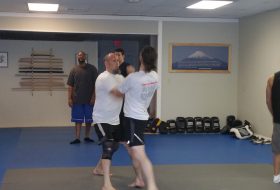To start off 2019.
A question came in my mailbox this morning from one of the guys on the course and he wondered about Latihan Berpasangan and why I don’t really have that many. I went on at length so I thought I would pass it on and expand it even further here. There are a lot of reasons.
In the past I have used fixed latihan berpasangan but I felt like using fixed drills defeats the purpose and value of a drill. When the drill is used and the movement skill is developed the drill really serves no purpose any longer. It should be discarded.
So I do still use latihan berpasangan and for those who have trained with me personally at length you would see them pulled out form time to time and modified to teach an idea.
As instructors you probably all have some in your hat that you can use. And if you don’t…. guess what? You DON’T need them. It’s just a way to build repetition quickly and get the motions.
The whole of the Pencak Silat PERTEMPURAN system is based on Latihan IMO. But one side at a time.
Every entry is an exercise in feel and distance and timing. Every attack thrown by a practitioner should likewise be the practice of throwing a real attack.
When I trained in Pamur they had 108 (I think… it’s been awhile) methods you learned as counters to attacks based on your Jurus-jurus. Each attack was a real attack.
Then you learn to put them together by using Kembangan or Jurus-jurus latihan. This is the process of adaptability—not memorization. Then through the use of Bela-diri you learn to apply.
What PSP is designed for is to give you all of the tools, mechanics, as a baseline of a lot of different pencak silat systems—and in fact a lot of systems from around the world—in a pencak silat framework that is more applicable than not.
What I have seen from drills is most of the time some of the most critical components are left out of them—spatial awareness, mobility, responsiveness, etc. They are often focused on hands in a very limited fashion and the value of such training is almost none beyond the learning of those movements—the drills are not actually about application.
In addition, I find that kind of drilling gives people a false sense of ability. When it completely disregards everything that is dynamic about a fight.
Even the basic 3-count or tangan bertenunan (weaving hands) drill requires a person drilling with you to act in a certain way in order for it to work—but that’s not what untrained people do.
So is it really a realistic or even worthwhile drill to learn in that manner if it actually doesn’t apply that way? Why not apply it and figure out how to drill it from real application? Just asking for a friend….
Most people who are good at drills are not necessarily good at fighting. Skill in drilling does not directly equate to ability in personal combat.
That said, I no longer really use FIXED drills but I do create drills in the moment to get people somewhat comfortable and then I drop them. It’s simply to embed a mechanic.
You’ll find with PSP that I don’t have many rules. You have to be good at entering. You have to be good at being adaptable. Focus on what YOU do best. Allow others to do the same.
And If you want to create drills along the way to teach that is up to you. I only test on application and understanding.
Most of what you’ll find in PSP is that it’s focused on fundamentals. Everything is about performing the fundamentals with excellence and then you have room to bring your own flavor as an instructor.
In reality, it is only the fundamentals that are used in combat. Almost nothing else.
The history of PSP is not Cimande which has a lot of seated material. It is also not Mande Muda though I have some experience with Mande Muda (which is really just a variety pack of several arts—one of which is Cimande). The name means New Cimande.
What I teach is based on a Maduran system known as Pamur primarily, combined with a Sumatran to Malaysia system known as Raja Sterlak. Which itself was based on Sterlak, Sitaralak, Stralak—all names for the same thing. A system of pencak silat that is known as Jati Wisesa, which is a variant of Gaja Putih and is the basis for Guru Roedy Wiranatakusumah’s Silat Sunda. And finally another system known as Raja Monyet out of Bali.
I’ve spent time in Indonesia training and have experienced many other systems and I’ve seen and trained in about 16 different systems in total including kung fu, harimau, kuntao, and FIlipino arts and PSP is my revelation of exposure to all those things.
The cross points of where they all meet. You can look at any system of pencak silat and find similarity in what we do. That was the intent.
I wanted to focus on what was similar rather than what was different.
And practical for a western body with limited time. A working man’s pencak silat.
More than you probably wanted to know but may find interesting.



